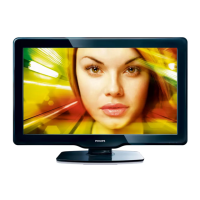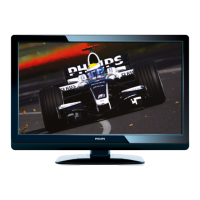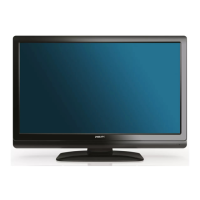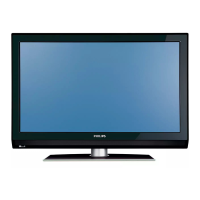Do you have a question about the Philips 42PFL3605/77 and is the answer not in the manual?
Follow all instructions, avoid water, use dry cloth, ensure ventilation, and handle plugs carefully.
Prevent shock, fire risks, proper cord handling, stability, and child safety measures.
Read all instructions; warranty void if not followed.
Introduction to side controls, indicators, and remote control.
Switching on/off, channels, connected devices, and volume adjustment.
Accessing menus, settings, timers, favorites, and closed captions.
Legal notices regarding company copyrights and registered trademarks.
Explanation of display pixel properties and acceptable variations.
Details on serviceable parts, repair procedures, and warranty voidance.
Avoid water, liquids, flames, heat sources, and inserting objects into openings.
Proper lifting, mounting, child safety, and overheating prevention.
Power cord safety, hearing protection, and low temperature handling.
Avoiding stationary images, cleaning, and screen protection.
Guidelines for recycling electronic products and batteries.
Identification and function of buttons on the TV's side.
Diagram and labeling of the remote control buttons.
Explanations for each button on the remote control.
Guidance on effective remote use and signal range.
Procedures for powering the TV on, off, and standby.
Changing channels via buttons, numeric input, or channel grid.
Switching between different input sources for connected devices.
How to control volume, mute, and unmute the TV.
Steps to open and navigate the TV's main menu system.
How to remove devices no longer connected to the TV.
Applying pre-defined picture settings for various viewing modes.
Fine-tuning brightness, contrast, color, sharpness, and other visual parameters.
Changing aspect ratios like 4:3, 16:9, zoom, and unscaled.
Applying pre-defined sound settings for different audio types.
Fine-tuning bass, treble, balance, and speaker output.
Creating, selecting, and adding channels to favorite lists.
Removing specific channels from favorite lists.
Configuring the TV clock and using sleep timers.
Setting timers for TV power-on or standby.
Creating or modifying the PIN for TV lock features.
Preventing access to all channels and connected devices.
Securing specific channels with a lock.
Enabling and configuring closed caption display options.
Connecting USB drives and accessing the content browser.
Navigating and viewing photo files from a USB device.
Customizing slide shows with transition and frequency settings.
Selecting and playing music files from USB storage.
Proper procedure to avoid data corruption when removing USB devices.
Checking, downloading, and installing software updates.
Adjusting location, volume bar, EasyLink, and other system settings.
Activating demos to explore TV features.
Restoring the TV to its original default configuration.
Choosing the correct broadcast source for channel tuning.
Performing an automatic search for available TV channels.
Manually tuning analog channels and system settings.
Hiding unwanted channels from the channel list or grid.
Customizing channel names for easier identification.
Changing the sequence of channels in the channel grid.
Connecting TV antenna, audio out, and component video sources.
CVI/CVI 2 (YPbPr and Audio L/R) connections for video and audio.
Connecting computers via VGA/PC and high-definition devices via HDMI.
Analog audio input for video devices connected to the side panel.
Connecting analog video devices like VCRs and camcorders.
Connecting USB storage devices for data access.
Connecting PCs via HDMI, DVI-HDMI, or VGA cables.
Utilizing HDMI cables and HDMI-DVI adapters for connectivity.
Instructions for connecting the TV to a computer using a VGA cable.
Overview of HDMI CEC control for connected devices.
Managing the Philips EasyLink feature.
One-touch play, standby, and system audio control explained.
Using the security slot to deter theft.
List of resolutions and refresh rates for HDMI and VGA inputs.
Supported USB storage formats and multimedia file types (JPEG, MP3).
Antenna input, TV system, video playback, and power consumption details.
Information on purchasing and using compatible TV mounts.
Dimensions, weight, and stand options for various TV models.
Solutions for TV not switching on or remote control malfunctions.
Troubleshooting missing channels and poor TV reception.
Solutions for scenarios with no picture or only sound.
Diagnosing sound problems and HDMI connection errors.
Resolving issues with unstable computer display on the TV.
Steps for seeking assistance when problems persist.
List of authorized service centers in the Capital Federal region.
Authorized service locations in the Gran Buenos Aires region.
Authorized service locations across various Argentine provinces.











